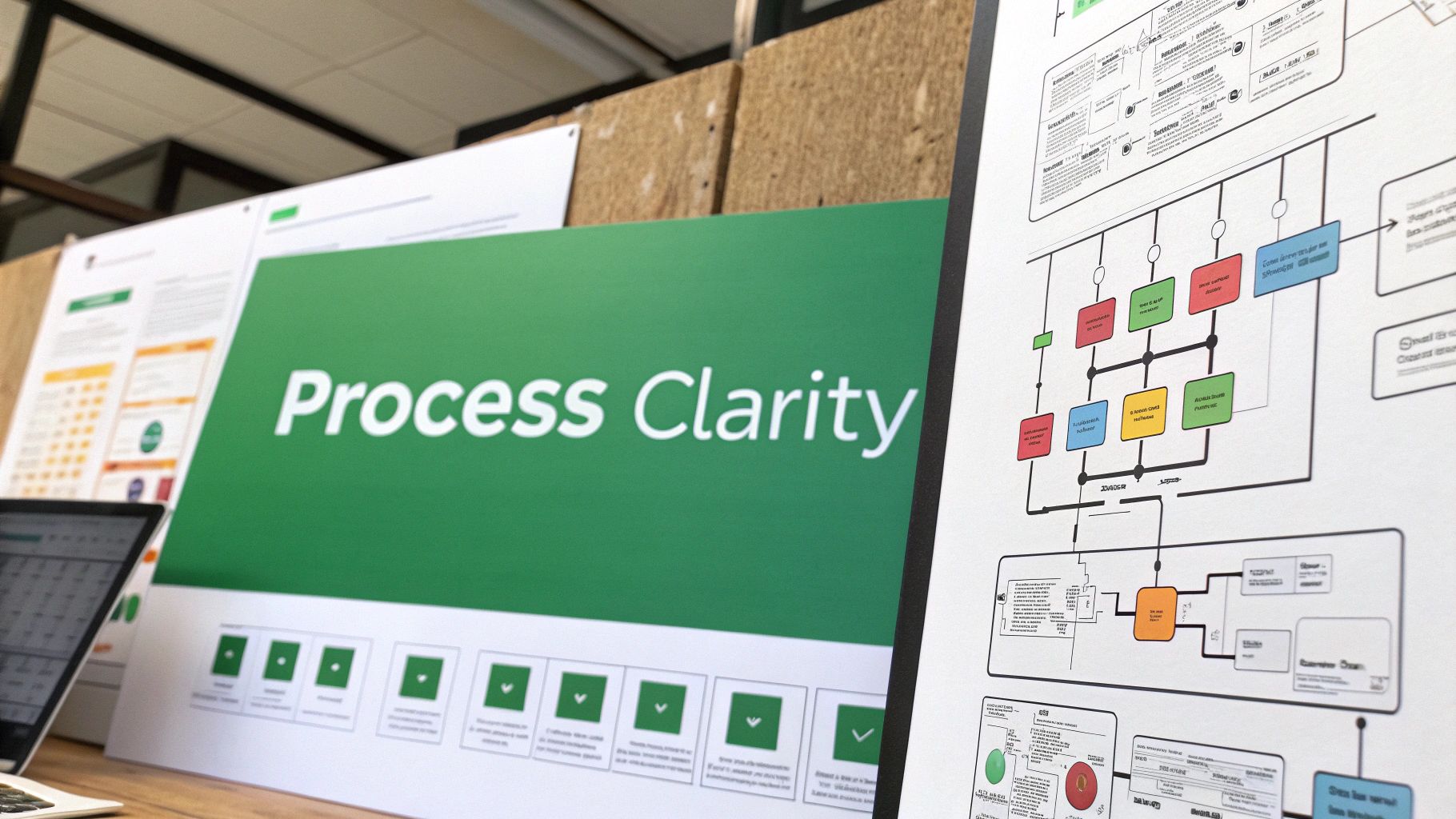Breaking Free from Traditional Documentation Practices

Software teams often struggle with outdated and irrelevant documentation that causes more problems than it solves. Research shows that developers spend nearly 58% of their time trying to understand code - a task that becomes much harder when documentation doesn’t match the actual codebase. This disconnect between code and documentation wastes valuable development time and delays project completion. The solution? A modern approach called “documentation as code” (DaC).
The Power of Documentation as Code
DaC completely changes how teams create and maintain documentation by making it an integral part of software development. Rather than treating docs as an afterthought, DaC applies the same disciplined processes used for code - writing in simple formats like Markdown, storing everything in version control with Git, and requiring proper reviews and testing. This tight integration ensures documentation stays current and useful.
Real-World Examples of DaC Success
Major tech companies have seen excellent results after adopting DaC practices. Both Google and Spotify use specialized tools like TechDocs and Backstage to manage documentation right alongside their code. This makes docs easy to find, search, and keep in sync with changes. The shared responsibility for documentation quality leads to more frequent reviews and updates from the whole team.
Benefits of Embracing DaC
DaC offers clear advantages over traditional documentation methods. First, it improves how teams work together since everyone can contribute through the same version control and review process. The use of automated testing catches errors early, preventing docs from becoming outdated. Simple text formats like Markdown let developers update documentation quickly without getting stuck on formatting details.
Studies highlight another key benefit: DaC leads to more consistent documentation updates. With traditional approaches, code and documentation changes happen together only 12% of the time, leaving most updates out of sync. But when documentation is embedded in the development workflow, teams naturally keep everything current. This means developers always have accurate information when they need it.
By making documentation part of the core development process rather than a separate task, DaC helps teams create and maintain better documentation with less effort. The result is improved productivity, fewer errors, and documentation that actually helps rather than hinders development work.
Building Your Documentation as Code Toolkit
Moving from basic version control to a full Documentation as Code (DaC) system requires carefully selecting the right combination of tools. A well-chosen toolkit helps teams create, update, and maintain documentation efficiently while keeping it tightly integrated with code. Let’s explore the key components needed to build an effective DaC workflow.
Choosing the Right Markup Language
The foundation of DaC starts with selecting a simple, text-based markup language. Markdown stands out as an excellent choice because developers can write content quickly without getting bogged down in complex formatting. Major companies like Twitter and Google have embraced Markdown, storing documentation files right alongside their code in dedicated ‘docs’ folders. This setup makes it natural for developers to update docs as they modify code.
Leveraging Documentation Platforms
While Markdown handles the writing side, you’ll need robust platforms to manage and display your documentation effectively. Spotify’s Backstage and Read the Docs offer powerful features like centralized builds, search capabilities, and easy navigation. These platforms connect smoothly with continuous integration pipelines, automatically rebuilding docs whenever code changes. This tight integration helps ensure documentation stays fresh and reliable.
Essential Tools for Documentation as Code
A complete DaC toolkit includes several key components beyond markup and platforms:
- Version Control Systems: Tools like Git track documentation changes and enable collaborative review processes, just like with code
- Text Editors: Popular editors like VS Code and Sublime Text make writing Markdown pleasant with features like syntax highlighting
- Linters and Style Guides: These tools maintain consistent formatting across all documentation, similar to code style enforcement
- Testing Frameworks: Automated tests catch broken links, verify examples work, and prevent other documentation problems before they reach users
Addressing Integration Challenges
Setting up a DaC system does come with some hurdles to overcome. Teams need time to configure tools properly and adjust to new documentation workflows. The initial effort of connecting various components into your development pipeline requires careful planning. However, companies like Spotify and Google have shown that investing in proper DaC tooling pays off through better documentation quality and more efficient development processes. By thoughtfully selecting and implementing the right tools, you can create a documentation system that truly works as an extension of your codebase.
Creating a Documentation-First Development Culture
Creating effective documentation requires fundamentally changing how development teams work, not just adopting new tools. When teams prioritize documentation from the start, it becomes a natural part of development rather than a task tacked on at the end. This approach ensures documentation stays current with code changes and provides real value to the team.
Fostering Collaboration and Ownership
Great documentation depends on everyone contributing - developers, product managers, and other team members all play key roles in maintaining quality. By making documentation reviews part of the standard pull request process, teams can verify that docs are updated whenever code changes. For example, when reviewing a pull request, developers can check both code changes and corresponding documentation updates. This shared responsibility helps prevent documentation from becoming outdated over time.
Practical Strategies for Implementation
Teams can take concrete steps to make documentation a seamless part of their workflow. Start by creating clear documentation guidelines and style standards that everyone follows. Just like coding conventions help maintain consistent code, documentation standards ensure everything is easy to read and maintain over time.
Make documentation part of your regular development process by including it in sprint planning and allocating dedicated time for updates. When teams treat documentation as essential rather than optional, it’s more likely to stay current with code changes. This prevents documentation from falling behind and ensures it evolves naturally with the codebase.
Overcoming Resistance to Change
It’s normal for some team members to resist new documentation requirements at first. Many developers see it as extra work outside their main responsibilities. The key is showing how good documentation directly benefits everyone - research shows developers spend about 58% of their time trying to understand existing code. Having clear, accurate documentation significantly reduces this overhead and makes the whole team more productive.
Real examples help demonstrate the value. Major tech companies like Google and Spotify have successfully implemented documentation-as-code approaches, leading to measurable improvements in developer efficiency and project outcomes. These concrete success stories show what’s possible when teams commit to documentation first.
Building a Culture of Continuous Improvement
Creating a documentation-first culture takes ongoing effort and refinement. Regularly gather feedback from documentation users and track how docs are being used. Review and update documentation systematically, just like you would with code. This ensures documentation remains helpful and relevant to the team’s needs. When teams commit to constantly improving their documentation practices, it becomes a natural and valuable part of how they work.

Measuring What Matters in Documentation
Creating good documentation involves more than selecting tools and setting up processes. You need concrete ways to evaluate if your docs actually help users. Let’s explore how to measure and improve documentation quality systematically.
Key Metrics for Documentation Health
Like tracking bugs and test coverage in code, you need specific metrics to assess documentation quality. Here are the essential measures to focus on:
- Findability: Monitor how easily users can locate information. Look at search logs, analyze common queries, and watch users navigate your docs to spot gaps and friction points.
- Accuracy: Check if content stays current and correct. Use version control and automated tests to flag outdated sections.
- Comprehensiveness: Ensure you cover all key topics. Ask users what’s missing and which areas need more detail.
- Accessibility: Make docs work for everyone. Run accessibility scans and follow WCAG guidelines for inclusive content.
- Developer Satisfaction: Get direct user feedback. Send regular surveys and add feedback forms to measure if docs meet developer needs.
Tracking Improvements and Justifying Investment
Good metrics help show the impact of documentation work. Track specific data points like:
- Fewer support tickets about unclear docs
- Higher satisfaction scores after doc updates
- Faster onboarding for new developers This concrete data helps prove the value of documentation investments to stakeholders and guides future improvements.
Implementing Automated Quality Checks
Scale your documentation quality efforts with automation. Set up checks for:
- Broken Links: Regular scans catch dead links before users do
- Code Examples: Automated tests verify that sample code actually works
- Style Rules: Linters enforce consistent writing, just like code style guides These automated checks catch issues early when they’re easier to fix.
Maintaining Consistency Across Distributed Teams
When teams work remotely, having docs in version control keeps everyone aligned. Store everything in a central repo where the whole team can contribute. Check out our guide on How to master Documentation as code for more details. Use templates and style guides to keep voice and format consistent across different authors.
By measuring what matters and automating quality checks, you can build documentation that truly serves users while scaling efficiently with your team. Focus on these key areas to create docs that make a real difference in your development process.
Automating Your Documentation Workflow

Making documentation a core part of your development process requires smart automation. By automating routine documentation tasks, teams can dedicate more time to improving content quality while ensuring docs stay in perfect sync with code changes. This is where treating documentation as code becomes incredibly practical. Picture having documentation that updates itself automatically whenever code changes - no more confusion from outdated guides or contradicting information. That’s the real value of building an automated documentation workflow.
Implementing Automated Testing and Validation
Documentation needs thorough testing, just like code does. Setting up automated tests for documentation catches issues early and maintains high quality standards. These tests can scan for broken links, verify code examples work correctly, and check that style guidelines are followed. By running automated checks before docs go live, you can feel confident about their accuracy - similar to how unit tests verify code behavior. This approach not only produces better documentation but also reduces the time spent on manual reviews.
Building a Robust Documentation Pipeline
A well-designed documentation pipeline treats docs with the same rigor as application code by integrating them into your CI/CD process. This means documentation automatically rebuilds and deploys with every code commit. As a result, your docs stay perfectly aligned with code changes, minimizing the risk of outdated information. Quick feedback loops also help catch documentation issues early in development.
Practical Approaches to Automation
Here are concrete ways to automate your documentation workflow:
- Automated Link Checkers: Regular scans ensure all documentation links work properly
- Code Example Validation: Test code snippets alongside your main codebase to verify they work
- Automated Style Guides: Use linting tools to maintain consistent formatting across all docs
- Version Control Integration: Store documentation in Git to track changes and enable easy collaboration
Real-World Automation Examples
Many companies have successfully automated their documentation workflows. Google maintains advanced internal systems that generate docs directly from code. Open source projects often combine tools like Sphinx or MkDocs with CI services to automatically build and publish documentation. These real examples show how treating docs as code leads to more accurate content and major time savings, letting developers focus on writing better code while users benefit from reliable, current documentation.
Tailoring Automation to Your Team
Pick automation tools that match your team’s size and needs. Small teams might start with basic link checking and automated builds, while larger organizations can implement full documentation pipelines. Focus on tools that make your workflow smoother without adding unnecessary complexity. When you integrate documentation into your development pipeline, it naturally evolves alongside your software, providing everyone with accurate, up-to-date information when they need it.
Documentation as Code in Practice: Next-Level Strategies

Once you’ve established core documentation-as-code practices, it’s time to expand your approach to handle larger and more complex projects. This means going beyond basic implementation to create systems that scale effectively across teams and different types of documentation needs.
Handling Complex Documentation Needs
Modern software projects require many different types of documentation - from detailed API specifications to architectural diagrams and user guides. A documentation-as-code approach helps manage this complexity through clear organization and automation. For example, if you’re working on a project with multiple microservices, you might set up a central documentation repository that automatically pulls in API specs from each service’s codebase to keep everything in sync.
You can also use tools that generate visual documentation directly from your code. When developers make changes to the system architecture or dependencies, these diagrams update automatically to match. This makes it much easier for team members to understand how different parts of the system work together, especially when dealing with complex codebases.
Scaling Documentation for Large Teams
As more people contribute to a project’s documentation, maintaining quality and consistency becomes challenging. The solution is to apply the same principles we use for code quality to documentation. Just as we have coding standards and automated tests, documentation needs clear guidelines and automated checks.
Set up specific style rules for your documentation and implement them through automated tools. For example, use linters to check formatting, spelling, and terminology usage. This catches issues early and helps every team member produce consistent, high-quality documentation regardless of their writing experience.
Emerging Trends in Documentation Tooling
The tools available for documentation are getting better all the time. One major development is the rise of platforms that make documentation part of the developer’s daily workflow. For instance, Spotify’s Backstage brings together API documentation, service catalogs, and technical guides in one place, making it simple for developers to find and update information.
AI tools are also changing how we create and maintain documentation. New applications can help generate initial documentation drafts, suggest improvements to existing docs, and even assist with translations. This frees up developer time while still maintaining high documentation standards.
Avoiding Common Pitfalls
Success with documentation as code isn’t just about picking the right tools - it requires changing how teams think about documentation. Many teams make the mistake of focusing only on technical setup while neglecting the cultural shift needed to make documentation a priority.
Make documentation reviews part of your regular code review process. When developers update code, they should also update the related documentation. This keeps everything in sync and prevents the all-too-common problem of outdated documentation that no one trusts.
Start with small changes and build up gradually as your team adapts. Focus on creating a culture where documentation is valued as much as code, and adjust your approach based on what works best for your team. This steady approach helps create documentation practices that last and scale as your projects grow.
Ready to transform your documentation workflow and empower your development team? Discover how DocuWriter.ai can automate your code and API documentation, saving you valuable time and ensuring accuracy. Explore the possibilities at https://www.docuwriter.ai/.